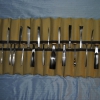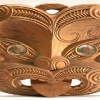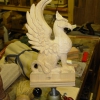This is the DVD on sharpening that I made in 2007 with Rob Cosman.
It's quite long (1hr.55mins) so we've divided it up along the lines of the DVD chapters. Rob plays the part of intelligent layman and I tell him about carving tools and how to go about sharpening them. I don't speak to camera, just to the guy next to me...

| 28 May 2022 10:21
Thanks for these videos. I have finally managed to hand sharpen a gauge with an inner bevel, and it’s fantastic. What a difference! I tried a few different stones but then invested in Arkansas black and translucent slip stones. Still took ages though. I think the biggest skill required is patience.

| 13 August 2020 14:54
Thanks Chris, no problem, I thought that might be the case. I have done some cabinet making in the past and enjoy the sharpening process so its something I like to explore anyway. I have been considering specific sized dowels with Scary Sharp lapping film for the inside bevel. Its a medium I have had good success with in the past.

| 13 August 2020 11:57
Sean - Sorry to have to report but these special slipstones, which I designed with carvers in mind, are no longer in production so you are really back to what I call the 'old days' where carvers have to make do with what they can find.
As a thought: you might like to consider some sort of powered wheel to first remove the bulk of the metal from the inside bevels of your larger gouges. There are some videos on power sharpening on this site. The final finish to a sharp edge is what takes a lot to the time in the commissioning.

| 13 August 2020 09:35
Hi Chris, New to the site and carving and enjoying the beginners course. Can you tell me if the larger slip stones for the internal bevel are still available and perhaps any retailer that might stock them. Many thanks
Sean

| 22 July 2020 07:11
Imran - The actual cutting edge - the 'sweep' (Sheffield number) and width - is the same for fishtails as regular, parallel sided gouges. Thus you can get a fishtail version of any regular gouge if you so wanted.
The sharpening is exactly the same, with the proviso that you need to protect those corners of a fishtail, which is the whole point of the tool, and not over rotate as you sharpen and remove them.

| 22 July 2020 01:40
Hi Chris. This question pertains to sharpening fishtail chisels and gouges. The cutting edge profile being different than the straight chisels and gouges, does one commission and sharpen them differently? I did not find this information in the videos or your books, I might have missed it. Thank you

| 27 May 2020 07:41
Marvin - Well done. Persistence is a key attribute for a carver!

| 27 May 2020 03:21
I've been concentrating on getting sharpening down. I salvaged a gouge, I had sharpened it watching Chris's teachings but had lost the corners. So I took it back to square, resharpened and repeated the process until I finally got it right. Then I sharpened my other full size gouges with pretty good success. I turned to a fishtail gouge I thought I had ruined earlier in my progress (February). I stayed on it sharpening it over and over - finally success!
I felt myself getting a little cocky, until I ruined a smaller bent gouge. It looks like the head of a demon with horns; it just blet out in the middle after I thought it was good to go! My confidence took a hit, so I'm realizing I'm not the Master Sharpener I thought I was...

| 04 September 2019 13:25
Gordon - SMG is independent from myself and all I know is that Mark has of necessity had to dig into other things for a short while, with every intention of picking up asap.
You might like to email him from SMG for an update? (It's what I'd have to do myself to answer this question.)

| 04 September 2019 01:58
Thanks, Chris. Meanwhile I have used sandpaper while conditioning a couple of gouges, and it is certainly possible. Your point about using cloth-backed abrasive is a good one. I used paper-backed, which not only wore out quickly but did not conform well to the shaped sticks. I'll look for cloth-backed. I have ordered some slipstones online from my excellent supplier in England (I am in Hong Kong) and will see how these work.
Any idea when Sharpen My Gouge will be back in action?

| 18 August 2019 13:15
Gordon - It looks like the special slipstones are done for. Norton stopped production a while ago and I have failed to find an alternative manufacturer. Too small and specialised a market for businesses to be interested.
So we are back to where we were before. There are certainly slipstones around but the shapes are nothing like as efficient. Look around, search online and buy what you can. I aim to make a video on slipstones fairly soon, looking at alternatives to these I designed. We'll post in the bulletin as soon as it's in the offing.
You can certainly wrap abrasive paper around shaped sticks. You want to go for paper designed to work on metal. And cloth backed: even if it means cutting up a sanding belt, say. It will wear quickly but is just as quickly replaced.

| 18 August 2019 04:44
Would sandpaper wrapped around shaped wood work?

| 17 August 2019 22:57
Chris, are the Pye Norton slipstones still available? If not, where can I get similar ones? In particular, I cannot find coarse/fine stones suitable for forming the inside bevel.

| 02 February 2016 13:40
Martin - Understand now, thanks. Yes, it is a bit of a contradiction. There is no agreed basic set - ask any carver and you'll get a different answer because of personal preferences, methods of working and different work needing different tools etc. (Are you interested in sculpture, lettering, netsuke, light relief?) The danger with buying a set from a manufacturer is you end up with tools you don't use and I'm certain one-who-shall-not-be-named manufacturer dumped tools into their sets because they had a surplus, not because they were useful to beginners. However, when I started instructing I kept getting asked, 'What tools should I start with?', so I came up with a short list that never seemed to leave my bench. It was never meant to be a 'set' or definitive in any way. More: 'You asked my advice, this is as good as it gets! Buy a couple from this list, see what happens!' Over the years, I never changed my mind and since the video above they became the ones Auriou made, needing to call them a 'set' for marketing. So I guess they are even if I still don't think of them as such.

| 01 February 2016 19:50
Rob is asking here what gouges/chisels one needs to get started - 'is there a basic set?' to which you reply there is no real basic set though many manufacturers offer sets, since there are so many different types of carving these sets will often not have what you need - you need to know what you want to carve to select the tools needed.
This seems to contradict your endorsement of the 'Auriou Chris Pye Basic Woodcarving Tools' set.

| 01 February 2016 17:41
Martin - Not quite following you here. 2:40 is a (disclaimer) comment about safety; the link is to a list of the slipstones etc. Can you elaborate further please?

| 28 January 2016 19:46
Interesting comment @2:40 ... considering https://www.classichandtools.com/acatalog/Sharpening_-_Chris_Pye_Signature_Series.html

| 04 March 2014 17:20
Marie - Yes, indeed you can. In fact I sharpened my own tools on a coarse stone when I started, for quite a while, before I bought a grinder. The coarse India stone (or side of an India combination stone) is dark grey and is the one to use. The pink side of the combo. stone is 'fine' - somewhere between the coarse India and the Arkansas. It's nice to have but you can normally go straight from coarse to Arkansas stone. (Sorry, I don't know what 'crystolon' is, or even the numbers for the grits offhand.)

| 03 March 2014 21:17
Thanks Chris,
Another question: for the commissioning process, if I don't have a grinder, can I make do with the coarser side of the "Chris Pye India Stone"? Or should I get an even coarser stone - I believe in Norton terminology that would by a "Crystolon" stone. Do you happen the know the grit #s for the two sides of the India stone?

| 03 March 2014 15:32
Marie - You've more-or-less got it. Stropping regularly (perhaps 20 strops for 20 minutes hard carving) maintains the edge. The heavy duty metal removal is just getting the right shape to begin with; you won't need to repeat unless you ding the edge, for example. However, stropping tends to round the bevel, which lifts the cutting angle. So, in addition to stropping I keep a check on the cutting angle and occassionally - when I notice it - give the bevel a few stokes of the fine stone to keep it flat and low, and stopping at the edge. It's not really sharpening - the edge is sharp from the stropping - just flattening the bevel.

| 02 March 2014 23:28
Chris, could you comment on frequency?
On one of the spectrum we have a new tool that needs to be commissioned. So it needs the full treatment shown in this video series: grinding, honing stropping.
At the other end of the spectrum we have a tool that has already been properly commissioned. It needs a strop for every few hours of use.
Is that all that tool will ever need? Or will there come a time when the stropping just isn't enough and it needs to be honed again?
I assume that the only reason why you would ever go all the way back to the grinding wheel with a tool that had been properly commissioned is that it was somehow damaged.

| 09 December 2013 19:26
Colin - Look to the expanding directory on the left of the video and... VoilÃ?!

| 06 December 2013 16:39
Is episode 3 available on the site? I seem to have misplaced my cd and really want to watch it again

| 23 July 2013 20:49
I noticed that you were showing a Sheffield chart but have as myself Swiss Made tools. Is there a chart available for the Swiss system?

| 31 May 2013 07:52
Jon - Thanks, I think they really are too, but you don't need the whole 'set'. The sliptones come in different thicknesses depending on the size of tools you are using. The most useful pair (they come in matched pairs of coarse and fine) is probably the so-called 'sculpture' set, which deal with gouges 1/2in and wider. So you could just start there and see how you got on? The next most useful seems to be the next narrower pair (#1) but you can judge that by what sort of tools you want to sharpen. Not all carvers need the same slipstons by any means. I have no control over the costs, I'm afraid. I'm actually amazed that a huge firm like Norton even bothered with them - kudos, man. You have to see all these items as lifetime investments.

| 29 May 2013 23:39
Your Signature Series stones are the best, but costs $500 for the set.
What do you recommend for cheaper stones to start with?

| 19 May 2013 18:29
Netana - Sorry but I don't know it and of course it depends on what size and shape tools you want to sharpen and can it handle them. I had a look online and my big thought was that for such a big price you really need to see it in action: get to take along some gouges to a demo, for example, or have them refer you to a local carver who has one and can let you see it working. A dependable firm will help you here.

| 13 May 2013 21:45
Hi Chris, I like to compare my chisels to boats and the water is my wood.I try to get my chisels to glide through the wood like a well crafted boat.
But my main question is i am thinking of investing in a grinding tool called the jooltool.
Have you heard of this and do you recommend it.Thank you.

| 01 January 2013 21:07
Russell - Sharpening a carving tool is a bit like tuning a violin; it HAS to be done. I'm afraid the minimum layout for hand-sharpening is, essentially, what I present here: a coarse and fine bench stone, coarse and fine slipstones, a simple bench grinder and strops. I do understand your concerns when you are just starting but let me reassure you that the equipment may seem expensive but see it as an investment - I still have my stone from over 35 years ago. I had little money then, and it hurt! But they were among the best, most 'cost-effective' things I've ever spent money on. If it eases the pain, consider the cost of any other woodworking craft: a lathe, a set of bench planes for example, never mind a golf club or what one might spend on other interests! It IS an adventure, as you say, so best to go well equipped from the start...

| 29 December 2012 15:42
Hi Chris,
I am just about to start out on my woodcarving adventure and have to say this is an amazing earning resource. As i a about to start out i would ideally like to start in a minimal, cost effective manner. I have received one of your 11 piece Pfeil sets and am now about to look at sharpening them. I have watched the sharpening dvd series which is great. The one thing i am unsure of is what sharpening tools i can use to start off as a lot of the tools demonstrated are quite expensive for a beginner. What could i start with as a really basic sharpening set. Thanks Russell

| 07 November 2012 08:44
Mario - I want to preface my reply with a 'tough love' warning! It's really important to learn how to do the sharpening yourself. I doubt whether anyone can give you the exact configuration that you like - unless it's your apprentice. (You may prefer more of less of an inside bevel, or a slightly rounded cutting edge, say. There is variation between how carvers like to work and thus how the tools should look, all of which is fine: it's the end result, the carving, that matters.) At the end of the day, sharpening is a discrete skill and the more you carve the more you get to practise it. As I say under the video: "This is the full 'commissioning', the full monty. You only need to do this once when you acquire your gouge (if it needs it). After that it's maintainance - stropping." It's like tuning a guitar: a major tune to start with then tweaking the pegs as you go along. So don't be put off: Take just one tool and keep at it until you get it right. Then try a second - you'll sharpen it in much quicker. And so on until sharpening is second nature; just something you do as a carver. You'll never regret it!

| 06 November 2012 08:56
Hi Chris, Is there anywhere in the UK that I could send my gouges to have them professionally sharpened?

| 19 July 2012 00:30
Great series of clips Chris & Carrie (Rob too)... This is a perfect example of the merging of the videos and your books (in the case of sharpening see his book "Woodcarving: Tools, Material & Equipment, Volume 1").
Your written word offers all the subtleties and details that would otherwise overwhelm a video, where the video captures the physical technique and real life application of the tools (which would overwhelm even one of Chris' books).. EXCEPTIONAL WORK YOU TWO (or three with the addition of Rob Cosman)

| 12 May 2012 18:46
Steven - You probably only need to sell the one. Your choice as to which. Try a web search. Also Tools for Working Wood in the USA or Classic Hand Tools in the UK.

| 11 May 2012 22:38
Hhhhmmm.... Pye/Norton slipstones.... Kowa-bunga Buffalo Bob! Somehow I must have missed these little gems.... So, what is a source for these slip-stones that will probably require me to sell my grandkids?
thanks C.

| 22 April 2012 20:09
as a total novice i thought the content was extremely informative and in just over 8 minutes i learnt more than i could have done in long periods of reading a book. the quality is fine and i cannot wait to see more

| 19 April 2012 10:18
Chris: I think that the other comments are fine as far as aspect ratio and such. I have no problem with black bands to help correct the aspect ratio. The sound seemed good to me., Personally, I am much more interested in the content of the video. I especially like that someone has finally not just recognized but verbalized that most slip stones available to use are for the most part useless or junk. They never fit the gouges properly and one is contantly fighting to get the entire burr off and you never really get the finish and edge you are looking for. I have been working on designing my own to compensate for the lack of what is really necessary to do the job right. As I said, it is in the content of the video that I am keenly interested in. And I certainly hope that you do post these videos. It would be of great help to most of us, and in particular those of us just starting out, as well as letting us know that there are quality functional sharpening stones available. Thanks so much.

| 18 April 2012 14:15
Excellent idea. The quality of both sound and vision is very good as is the instruction given. I look forward to seeing the complete DVD.

| 17 April 2012 20:26
Thanks very much; good quality and its a very good idea